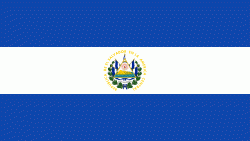Tonacatepeque
Tonacatepeque is a municipality in the San Salvador department of El Salvador. It has a population of 90,896 inhabitants according to the 2007 Census. This makes this municipality twelfth largest in terms of population in El Salvador.
According to archeological findings, Tonacatepeque was first founded as a small settlement by the Pipil people in mountains just south of its current location. Under the Pipil people, Tonacatepeque was likely a small, minor chiefdom threatened by possible incursions by the Señorío de Cuscatlán (Lordship of Cuscatlán). During the conquest and settlement of the newly discovered Americas, an order of Franciscan missionaries attempted to convert the indigenous people, establishing a new church. The patron saint of Tonacatepeque under the Franciscan order was San Nicolás Obispo de Mira (Saint Nicholas Bishop of Myra). Hence, the burgeoning settlement took on the name San Nicolás Tonacatepeque. According to local history, around 1880 the foundations and ruins of that first Franciscan church were still visible.
The current location of Tonacatepeque was established in 1560. By 1770, the town had its own established church and included annexed areas such as Soyapango, Ilopango, and the San José Guayabal Valley. At this point, the town was home to 96 families, comprising 628 people. In 1786, Tonacatepeque was integrated within the jurisdiction of San Salvador. In 1807, following a census done by Intendent Don Antonio Gutiérrez Ulloa, Tonacatepque was classified as a "pueblo" or small village, inhabited by 17 Spaniards, 718 natives, and 619 mestizos. Almost seven decades later, on March 7, 1874, the Salvadoran Legislature (under the administration of Field Marshal Santiago González) authorized the reclassification of Tonacatepeque from "pueblo" to "Villa." The title of City was conferred by legislative decree on February 6, 1878, during the administration of Dr. Rafael Zaldívar. On March 17, 1892, Tonacatepeque was made District Center by legislative decree under the administration of General Carlos Ezeta. The new administrative district included the populations of Toncatepeque, Apopa, Ilopango, San Martín, Nejapa, Guazapa, Aguilares, and El Paisnal.
According to archeological findings, Tonacatepeque was first founded as a small settlement by the Pipil people in mountains just south of its current location. Under the Pipil people, Tonacatepeque was likely a small, minor chiefdom threatened by possible incursions by the Señorío de Cuscatlán (Lordship of Cuscatlán). During the conquest and settlement of the newly discovered Americas, an order of Franciscan missionaries attempted to convert the indigenous people, establishing a new church. The patron saint of Tonacatepeque under the Franciscan order was San Nicolás Obispo de Mira (Saint Nicholas Bishop of Myra). Hence, the burgeoning settlement took on the name San Nicolás Tonacatepeque. According to local history, around 1880 the foundations and ruins of that first Franciscan church were still visible.
The current location of Tonacatepeque was established in 1560. By 1770, the town had its own established church and included annexed areas such as Soyapango, Ilopango, and the San José Guayabal Valley. At this point, the town was home to 96 families, comprising 628 people. In 1786, Tonacatepeque was integrated within the jurisdiction of San Salvador. In 1807, following a census done by Intendent Don Antonio Gutiérrez Ulloa, Tonacatepque was classified as a "pueblo" or small village, inhabited by 17 Spaniards, 718 natives, and 619 mestizos. Almost seven decades later, on March 7, 1874, the Salvadoran Legislature (under the administration of Field Marshal Santiago González) authorized the reclassification of Tonacatepeque from "pueblo" to "Villa." The title of City was conferred by legislative decree on February 6, 1878, during the administration of Dr. Rafael Zaldívar. On March 17, 1892, Tonacatepeque was made District Center by legislative decree under the administration of General Carlos Ezeta. The new administrative district included the populations of Toncatepeque, Apopa, Ilopango, San Martín, Nejapa, Guazapa, Aguilares, and El Paisnal.
Map - Tonacatepeque
Map
Country - El_Salvador
 |
 |
| Flag of El Salvador | |
Among the Mesoamerican nations that historically controlled the region are the Lenca (after 600 AD), the Mayans, and then the Cuzcatlecs. Archaeological monuments also suggest an early Olmec presence around the first millennium BC. In the beginning of the 16th century, the Spanish Empire conquered the Central American territory, incorporating it into the Viceroyalty of New Spain ruled from Mexico City. However the Viceroyalty of New Spain had little to no influence in the daily affairs of the isthmus, which was colonized in 1524. In 1609, the area was declared the Captaincy General of Guatemala by the Spanish, which included the territory that would become El Salvador until its independence from Spain in 1821. It was forcibly incorporated into the First Mexican Empire, then seceded, joining the Federal Republic of Central America in 1823. When the federation dissolved in 1841, El Salvador became a sovereign state, then formed a short-lived union with Honduras and Nicaragua called the Greater Republic of Central America, which lasted from 1895 to 1898.
Currency / Language
| ISO | Currency | Symbol | Significant figures |
|---|---|---|---|
| SVC | Salvadoran colón | 2 | |
| USD | United States dollar | $ | 2 |
| ISO | Language |
|---|---|
| ES | Spanish language |















